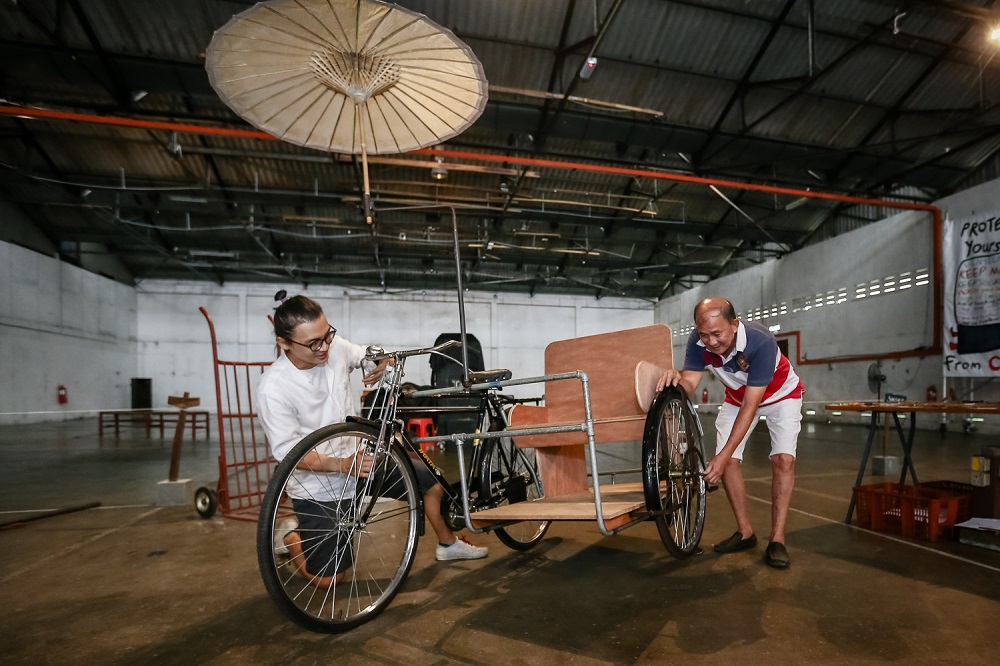Lim (left) learnt how to make a cargo beca under Diong’s guidance to archive and preserve the intricacies of the traditional Malaysian vehicle. – Pictures by Devan Manuel
PETALING JAYA, April 15 – Kuala Lumpur beca-maker Benny Diong may have closed his bicycle shop last year but he still remembers each component of the beca (trishaw).
Diong, 66, is one of KL’s last surviving beca-makers.
He used to make five to six becas daily with his brothers in Sin Hing, his now-defunct shop in Pudu Market using handcrafted and simple machine tools.
Sin Hing prided itself for making beca frames and was known for making two types of KL-style becas – passenger becas and cargo becas to customers from as far as Kota Baru, Klang, Bentong and Ipoh.
One unique difference between the KL-style becas from their counterparts in Penang, Melaka and Singapore is that it’s made from galvanised iron pipe that would be used for the vehicle’s frames.
Speaking to Malay Mail, one of the notable projects Diong recalls is making becas for trishaw peddlers back in the 1970s so that they could use them when they headed back to their hometown in China.
“We would assemble and number the parts such as iron pieces and put them into gunny sacks to be transported onto the ship,” he said.
“Once these trishaw men reached China, they would assemble them using the numbered iron pieces and individual parts.
“Not just that, Sin Hing also prided itself for making a beca to be put as a display in KL’s Federal Hotel so that tourists could admire and sit on it.”
Local famous roasted duck restaurant Sze Ngan Chye which was once a humble stall located in Petaling Street also had its famous cart built by Sin Hing including its wheels.
Diong, 66, is one of KL’s last surviving beca-makers.
Learning the trade through observation
The one trait that Diong learned from his beca-maker dad was learning through seeing and observing.
Diong and his brothers would watch their father toiling away at the different machines as they didn’t have a guided manual to help them work the machines.
“My dad had bought important tools from England and Germany and these machine tools helped us make our becas faster than the normal hand tools,” Diong said.
“At the age of 18, I worked in Sin Hing to continue the family business and observed how my dad would bend galvanised iron pipes into L-shapes to make the frames of the vehicle among other things.
“This method was known as cold-bending.
“One important tool that we made in the shop was the brass hubs, the central part of the wheel – first cast in a smelting facility with holes manually drilled into it so that wheel spokes could be inserted.”
He added that the becas he made can last from 30 to 40 years.
Asked whether he wanted to teach the secret of beca-making or host classes for anyone interested, Diong just shook his head.
“Why should I teach this secret to anyone? It’s a family secret.
“It takes a lot of years to master this art – and it’s not just something that anyone can learn as it takes patience and time,” he said.
Diong (right) teaches Lim the technique of bending steel, a vital process in beca-making.
Preserving the ‘beca’s’ heritage
One day when Diong was discarding his old machine tools, photographer Jeffrey Lim who stumbled upon his shop told the beca master that he would buy these remaining tools.
Lim also asked Diong to teach him how to make a beca.
For Lim, who is also a cultural worker and a documentarian, he saw the value in salvaging these remaining handcrafted tools to archive the beca-making process.
It was about a few years ago when Lim started documenting old heritage bicycle shops for his cycling and mapping projects.
“I’ve seen sifu (Diong) many times and persuaded him to teach me how to make the beca – it wasn’t easy as I had to befriend him first and let him know that it was for an archival project,” he said.
“I do not intend to be a master as I know that sifu had taken his whole life to learn how to make becas – I just want to experience making it.
“Maybe one day the National Archives of Malaysia, Malaysian Design Archives or even engineers can look at it and innovate the beca to something much more sophisticated than it is now?”
Lim added that he was impressed by Diong’s workmanship and skills because his talent is distinct from the other beca makers throughout the country.
He added that no two becas are the same.
And so Diong taught Lim how to make a cargo beca with a seat to be put on display at an exhibition taking place this month: “Building the Beca – Trades Archive”.
The exhibition has led Lim and his team to make a video documentation and publish a book illustrating the technical drawings, materials needed including the tools, and the method to make the beca.
“Since I was an apprentice, one of the things I’ve observed is how my body is like a machine when it moves to bend steel or work the hand tools.
“Diong would tease me at times to be faster at the machine I’m working at, just like under a typical strict Chinese apprenticeship.
“But we had great fun, he poked fun at me, and I learned the intricacies of machines and the components of the vehicle,” he said.
Lim, who has a keen interest in becas and bicycles, hopes that more people will continue having conversations about the beca so that it doesn’t become a cultural pride that will fade away with time.


